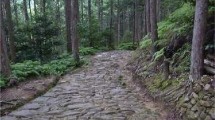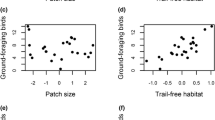Abstract
All the maintained trails in Great Smoky Mountains National Park were surveyed for width, depth, and a variety of types of erosion. Trail erosion is related to a number of environmental variables, including vegetation type, elevation, trail slope, and section of the park. Open grass balds and spruce-fir forest are the most erosion-sensitive plant communities, and the xeric oak and pine types are the least sensitive. Trails in virgin or mature forest tend to be in poorer condition than those in successional areas. The most important physical factor is the slope of the trail.
Trails in the Tennessee district are in slightly poorer condition, on the average, than those in the North Carolina district, but the Appalachian Trail is more eroded than either. A poor section of the park may have ten times the erosion of a good section. On an allpark basis, water erosion is the most important problem, with 15% of the trail surface affected.
A comparison of visitation patterns with trail condition indicates that redistribution of use would help to mitigate some erosion problems. Because trail condition is correlated to physical environmental factors, however, some sites will require intensive maintenance, even if visitation is low.
The data from this survey have already been used in environmental analysis of proposed developments within the park and can be applied to long-range planning for the park trail system as a whole.
Similar content being viewed by others
Literature Cited
Baron J. 1976. Environmental analysis of the proposed Blue Ridge Parkway Extension from Oconaluftee to Deep Creek Campground. Management Rept. No. 9, Vol. I. U.S. Department of the Interior, National Park Service, Uplands Field Research Laboratory, Great Smoky Mountains National Park, Tennessee, 99 pp.
Barr, A. J., and J. H. Goodnight. 1972. Statistical Analysis System. North Carolina State University. Raleigh (Computer Programs). 260 pp.
Bayfield, N. G. 1973. Use and deterioration of some Scottish hill paths. J. Applied Ecology 10:639–648.
Boorman, L. A., and R. M. Fuller. 1977. Studies of the impact of paths on the dune vegetation at Winterton, Norfolk, England. Biolical Conservation 12:205–215.
Bratton, S. P., M. G. Hickler, and J. H. Graves. 1977. Trail and campsite erosion survey for Great Smoky Mountains National Park. Management Rept. No. 16, Vols. I–IV. U.S. Department of the Interior, National Park Service, Uplands Field Research Laboratory, Great Smoky Mountains National Park, Tennessee, 567 pp.
Bratton, S. P., M. G. Hickler, and J. H. Graves. 1978. Visitor impact on back-country campsites in the Great Smoky Mountains. Submitted to Environmental Management.
Braun, E. L. 1950. Deciduous Forests of Eastern North America. Blakiston Co., Philadelphia, 576 pp.
Braun-Blanquet, J. 1932. Plant Sociology: The Study of Plant Communities. Transl. by G. D. Fuller and H. S. Conard. McGraw-Hill, New York, 439 pp.
Crawford, A. K., and M. J. Liddle. 1977. The effect of trampling on neutral grassland. Biolical Conservation 12:135–141.
Dale, D., and T. Weaver. 1974. Trampling effects on vegetation of the trail corridors of north Rocky Mountain forests. J. Applied Ecology 11:767–772.
Foin, T. C., E. O. Garton, C. W. Bowen, J. M. Everingham, and R. O. Schultz. 1977. Quantitative studies of visitor impacts on environments of Yosemite National Park, California, and their implications for park management policy. Environmental Management 5:1–22.
Hadley, J. B., and R. Goldsmith. 1963. Geology of the Eastern Great Smoky Mountains, North Carolina and Tennessee. U.S. Geological Survey Prof. Paper 349-B, pp. B1–B118.
Helgath, S. F. 1974. Selway-Bitteroot Wilderness Trail Deterioration Study. M.S. Thesis, Washington State University, Seattle, 106 pp.
King, P. B. 1964. Geology of the Central Great Smoky Mountains, Tennessee. U.S. Geological Survey Prof. Paper 349-C, pp. C1–C148.
King, P. B., R. B. Neuman, and J. Hadley. 1968. Geology of the Great Smoky Mountains National Park, Tennessee and North Carolina. U.S. Geological Survey Prof. Paper 587, 15 pp.
Laboratory for Computer Graphics and Spatial Analysis, Harvard University. 1972. CALFORM Manual 1.1 (and computer programs). Harvard University, Cambridge, Mass., 80 pp.
Leonard, R. E. 1976. Design capacity: A possible approach to some backcountry recreation management problems. Appalachia 42(2):20–21.
Liddle, M. J. 1975. A selective review of the ecological effects of human trampling on natural ecosystems. Biolical Conservation 7:17–36.
Merriam, L. C. Jr., and C. K. Smith. 1974. Visitor impact on newly developed campsites in the Boundary Waters Canoe Area. J. Forestry 72:627–630.
Nichols, R. 1977. The Ecological Effects of LeConte Lodge in the Great Smoky Mountains National Park. Rept. for the Superintendent, Great Smoky Mountains National Park, Tennessee, 97 pp.
Proudman, R. 1978. Evaluation and recommendations on trail problems along the Appalachian National Scenic Trail from Silers Bald to Inadu Knob, (Snake Den Trail) in the Great Smoky Mountains National Park, Unpublished report in General File Great Smoky Mountains National Park, Gatlinburg, Tennessee, 93 pp.
Soil Conservation Service. 1951. Soil Survey Manual. United States Department of Agriculture, U.S. Government Printing Office, Washington, D.C., 503 pp.
Stephens, L. A. Jr. 1969. A Comparison of Climatic Elements at Four Elevations in the Great Smoky Mountains. M.S. Thesis, University of Tennessee, Knoxville, 119 pp.
Whittaker, P. L. 1978. A Comparison of Surface Damage by Hiking and Horseback Riding in Great Smoky Mountains National Park. Management Rept. No. 24, U.S. Department of the Interior, National Park Service, Great Smoky Mountains National Park, Tennessee, 32 pp.
Whittaker, R. H. 1956. Vegetation of the Great Smoky Mountains. Ecol. Monogr. 26(1):1–80.
Willard, B., and J. Marr. 1970. Effects of human activities on alpine tundra ecosystems in Rocky Mountain National Park, Colorado. Biolical Conservation 2:257–265.
Wolfe, J. A. 1967. Forest soil characteristics as related to vegetation and bedrock in the spruce-fir zone of the Great Smoky Mountains. Ph.D. Thesis, Univ. Tennessee, Knoxville. 193 pp.
Author information
Authors and Affiliations
Rights and permissions
About this article
Cite this article
Bratton, S.P., Hickler, M.G. & Graves, J.H. Trail erosion patterns in Great Smoky Mountains National Park. Environmental Management 3, 431–445 (1979). https://doi.org/10.1007/BF01866582
Issue Date:
DOI: https://doi.org/10.1007/BF01866582




